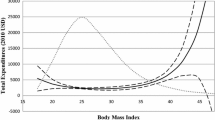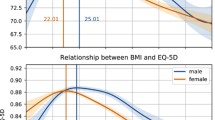Abstract
Objective
The prevalence of obesity and associated cardiometabolic risk factors such as diabetes, hyperlipidemia and hypertension is increasing significantly for all demographic groups.
Research design and methods
The 2000 and 2002 Medical Expenditure Panel Survey (MEPS), a nationally representative survey of the U.S. population, was used to estimate the marginal impact of obesity on health function, perception, and preferences for individuals with diabetes, hyperlipidemia, and hypertension using multivariate regression methods controlling for age, sex, race, ethnicity, education, income, insurance, smoking status, comorbidity, and proxy response. Three different instruments were used: SF-12 physical component scale (PCS-12) and mental component scale (MCS-12); EQ-5D index and visual analogue scale (VAS). Censored least absolute deviation was used for the EQ-5D and VAS (due to censoring) and ordinary least squares (OLS) was used for the PCS-12 and MCS-12.
Results
After controlling for sociodemographic characteristics, diabetes, hyperlipidemia, and hypertension were associated with significantly lower scores compared to normal weight individuals without the condition for all four instruments. Obesity significantly exacerbated this association. Controlling for comorbidity attenuated the negative association of obesity and cardiometabolic risk factors on instrument scores. In addition, scores decreased for increasing weight and number of risk factors.
Conclusions
Obesity significantly exacerbates the deleterious association between diabetes, hyperlipidemia, and hypertension, and health function, health perception, and preference-based scores in the United States.


Similar content being viewed by others
References
Flegal, K. M., Carroll, M. D., Ogden, C. L., & Johnson, C. L. (2002). Prevalence and trends in obesity among US adults, 1999–2000. Journal of the American Medical Association, 288, 1723–1727. doi:10.1001/jama.288.14.1723.
Mokdad, A. H., Serdula, M. K., Dietz, W. H., Bowman, B. A., Marks, J. S., & Koplan, J. P. (1999). The spread of the obesity epidemic in the United States, 1991–1998. Journal of the American Medical Association, 282, 1519–1522. doi:10.1001/jama.282.16.1519.
Bonow, R. O., Smaha, L. A., Smith, S. C., Jr., Mensah, G. A., & Lenfant, C. (2002). World Heart Day 2002: The international burden of cardiovascular disease: responding to the emerging global epidemic. Circulation, 106, 1602–1605. doi:10.1161/01.CIR.0000035036.22612.2B.
Greenlund, K. J., Zheng, Z. J., Keenan, N. L., et al. (2004). Trends in self-reported multiple cardiovascular disease risk factors among adults in the United States, 1991–1999. Archives of Internal Medicine, 164, 181–188. doi:10.1001/archinte.164.2.181.
American Heart Association. 2005. Heart Disease and Stroke Statistics—2005 Update. Dallas, TX: American Heart Association.
Kahn, R., Buse, J., Ferrannini, E., & Stern, M. (2005). The metabolic syndrome: Time for a critical appraisal: joint statement from the American Diabetes Association and the European Association for the Study of Diabetes. Diabetes Care, 28, 2289–2304. doi:10.2337/diacare.28.9.2289.
Ford, E. S. (2005). Risks for all-cause mortality, cardiovascular disease, and diabetes associated with the metabolic syndrome: A summary of the evidence. Diabetes Care, 28, 1769–1778. doi:10.2337/diacare.28.7.1769.
Jia, H., & Lubetkin, E. I. (2005). The impact of obesity on health-related quality-of-life in the general adult US population. Journal of Public Health (Oxford, England), 27, 156–164. doi:10.1093/pubmed/fdi025.
Katz, D. A., McHorney, C. A., & Atkinson, R. L. (2000). Impact of obesity on health-related quality of life in patients with chronic illness. Journal of General Internal Medicine, 15, 789–796. doi:10.1046/j.1525-1497.2000.90906.x.
Sullivan, P. W., & Ghushchyan, V. (2006). Preference-Based EQ-5D index scores for chronic conditions in the United States. Medical Decision Making, 26, 410–420. doi:10.1177/0272989X06290495.
Sullivan, P. W., Lawrence, W. F., Jr., & Ghushchyan, V. (2005). A national catalogue of preference-based scores for chronic conditions in the US. Medical Care, 43, 736–749. doi:10.1097/01.mlr.0000172050.67085.4f.
Sach, T. H., Barton, G. R., Doherty M., Muir K. R., Jenkinson C., & Avery A. J. (2006). The relationship between body mass index and health-related quality of life: comparing the EQ-5D, EuroQol VAS and SF-6D. International Journal of Obesity, 31, 189-196. doi:10.1038/sj.ijo.0803365
Clarke, P., Gray, A., & Holman, R. (2002). Estimating utility values for health states of type 2 diabetic patients using the EQ-5D (UKPDS 62). Medical Decision Making, 22, 340–349. doi:10.1177/027298902400448902.
Roca-Cusachs, A., Dalfo, A., Badia, X., Aristegui, I., & Roset, M. (2001). Relation between clinical and therapeutic variables and quality of life in hypertension. Journal of Hypertension, 19, 1913–1919. doi:10.1097/00004872-200110000-00028.
Erickson, S. R., Williams, B. C., & Gruppen, L. D. (2004). Relationship between symptoms and health-related quality of life in patients treated for hypertension. Pharmacotherapy, 24, 344–350. doi:10.1592/phco.24.4.344.33177.
Lalonde, L., Clarke, A. E., Joseph, L., Mackenzie, T., & Grover, S. A. (1999). Comparing the psychometric properties of preference-based and nonpreference-based health-related quality of life in coronary heart disease Canadian Collaborative Cardiac Assessment Group. Quality of Life Research, 8, 399–409. doi:10.1023/A:1008991816278.
Sullivan, P. W., Ghushchyan, V., Wyatt, H. R., Wu, E. Q., & Hill, J. O. (2007). Impact of cardiometabolic risk factor clusters on health-related quality of life in the US. Obesity (Silver Spring, Md.), 15, 511–521.
Heo, M., Allison, D. B., Faith, M. S., Zhu, S., & Fontaine, K. R. (2003). Obesity and quality of life: mediating effects of pain and comorbidities. Obesity Research, 11, 209–216. doi:10.1038/oby.2003.33.
Chambers, B. A., Guo, S. S., Siervogel, R., Hall, G., & Chumlea, W. C. (2002). Cumulative effects of cardiovascular disease risk factors on quality of life. The Journal of Nutrition Health & Aging, 6, 179–184.
Documentation Files, P.U.F. Agency for Healthcare Research and Quality (AHRQ). (2005). Accessed April 28, 2006, at http://www.meps.ahrq.gov/PUFFiles/H60/H60doc.htm.
Panel 7 Longitudinal Weight Files. Agency for Healthcare Research and Quality (AHRQ), (2005). Accessed November 10, 2003, at http://www.meps.ahrq.gov/PUFFiles/H80/H80doc.htm.
Guyatt, G. H., Osoba, D., Wu, A. W., Wyrwich, K. W., & Norman, G. R. (2002). Methods to explain the clinical significance of health status measures. Mayo Clinic Proceedings, 77, 371–383.
Hays, R. D., & Morales, L. S. (2001). The RAND-36 measure of health-related quality of life. Annals of Medicine, 33, 350–357. doi:10.3109/07853890109002089.
Walters, S. J., & Brazier, J. E. (2003). What is the relationship between the minimally important difference and health state utility values? The case of the SF-6D. Health and Quality of Life Outcomes, 1, 4. doi:10.1186/1477-7525-1-4.
Grootendorst, P., Feeny, D., & Furlong, W. (2000). Health Utilities Index Mark 3: Evidence of construct validity for stroke and arthritis in a population health survey. Medical Care, 38, 290–299. doi:10.1097/00005650-200003000-00006.
Lawrence, W. F., Fryback, D. G., Martin, P. A., Klein, R., & Klein, B. E. (1996). Health status and hypertension: a population-based study. Journal of Clinical Epidemiology, 49, 1239–1245. doi:10.1016/S0895-4356(96)00220-X.
Lalonde, L., O’Connor, A., Joseph, L., & Grover, S. A. (2004). Health-related quality of life in cardiac patients with dyslipidemia and hypertension. Quality of Life Research, 13, 793–804. doi:10.1023/B:QURE.0000021695.26201.a0.
Schlenk, E. A., Erlen, J. A., Dunbar-Jacob, J., et al. (1998). Health-related quality of life in chronic disorders: A comparison across studies using the MOS SF-36. Quality of Life Research, 7, 57–65. doi:10.1023/A:1008836922089.
Wee, H. L., Cheung, Y. B., Li, S. C., Fong, K. Y., & Thumboo, J. (2005). The impact of diabetes mellitus and other chronic medical conditions on health-related Quality of Life: Is the whole greater than the sum of its parts? Health and Quality of Life Outcomes, 3, 2. doi:10.1186/1477-7525-3-2.
Edwards, D. S., Winn, D. M., & Kuriantzik, V. (1994). Evaluation of the National Health Interview Survey diagnostic reporting. Hyattsville: National Center for Health Statistics; Report No. 2:1.
Palta, M., Prineas, R. J., Berman, R., & Hannan, P. (1982). Comparison of self-reported and measured height and weight. American Journal of Epidemiology, 115, 223–230.
Rowland, M. L. (1990). Self-reported weight and height. The American Journal of Clinical Nutrition, 52, 1125–1133.
Centers for Disease Control and Prevention. (2002). National Diabetes Fact Sheet: General Information and National Estimates on Diabetes in the U.S., 2000. Atlanta: Department of Health and Human Services, Centers for Disease Control and Prevention.
Acknowledgement
This research was supported by a research grant from Sanofi-Aventis.
Author information
Authors and Affiliations
Corresponding author
Rights and permissions
About this article
Cite this article
Sullivan, P.W., Ghushchyan, V.H. & Ben-Joseph, R. The impact of obesity on diabetes, hyperlipidemia and hypertension in the United States. Qual Life Res 17, 1063–1071 (2008). https://doi.org/10.1007/s11136-008-9385-7
Received:
Accepted:
Published:
Issue Date:
DOI: https://doi.org/10.1007/s11136-008-9385-7




